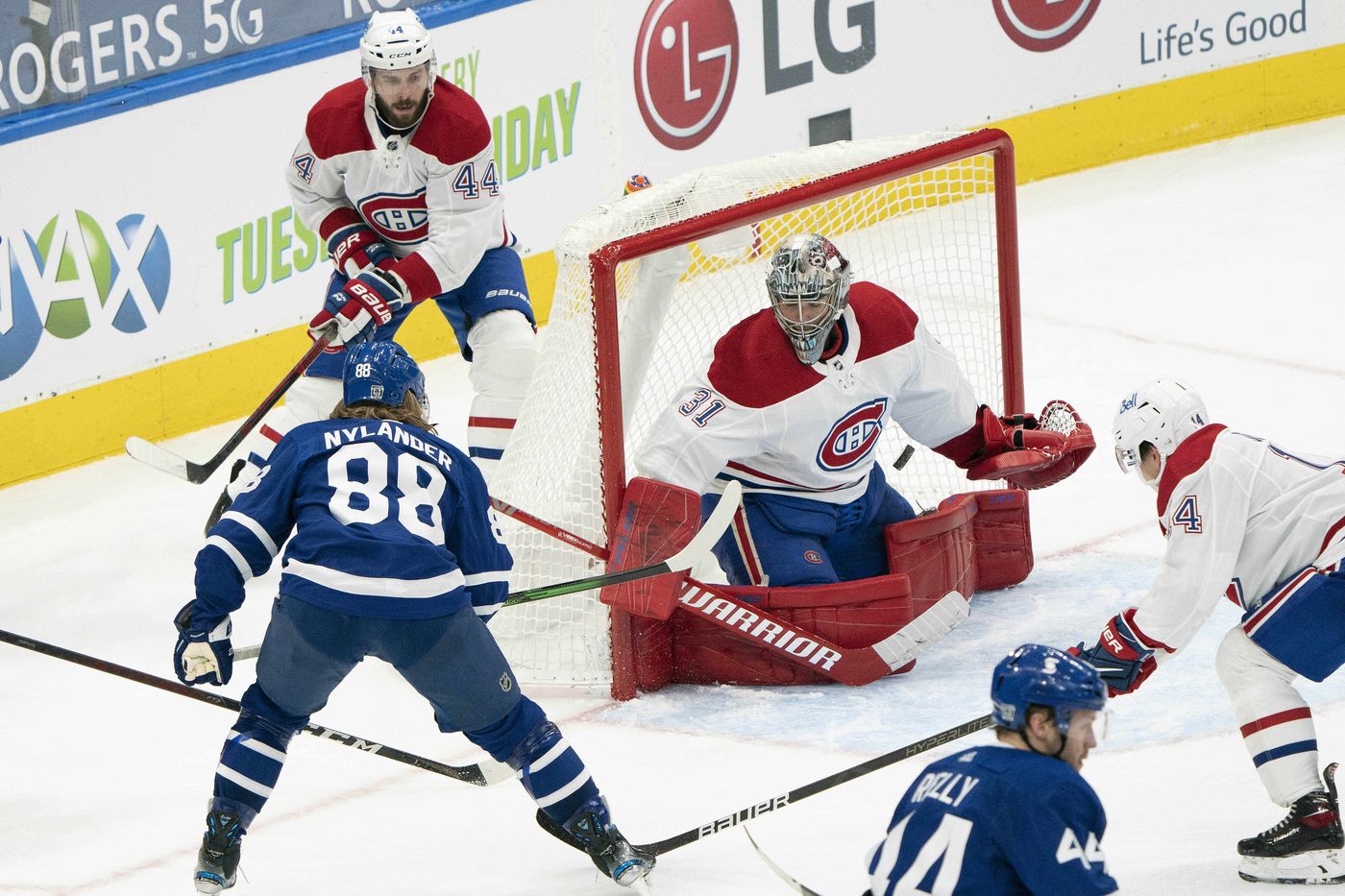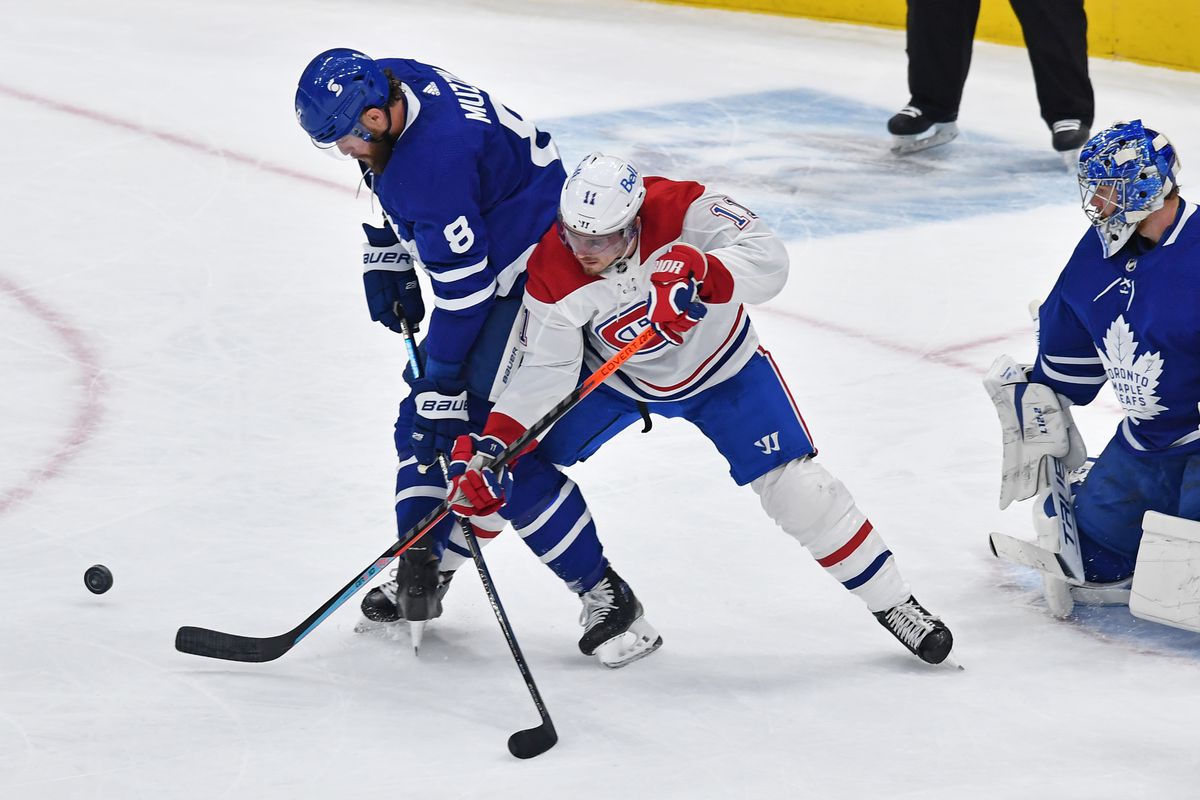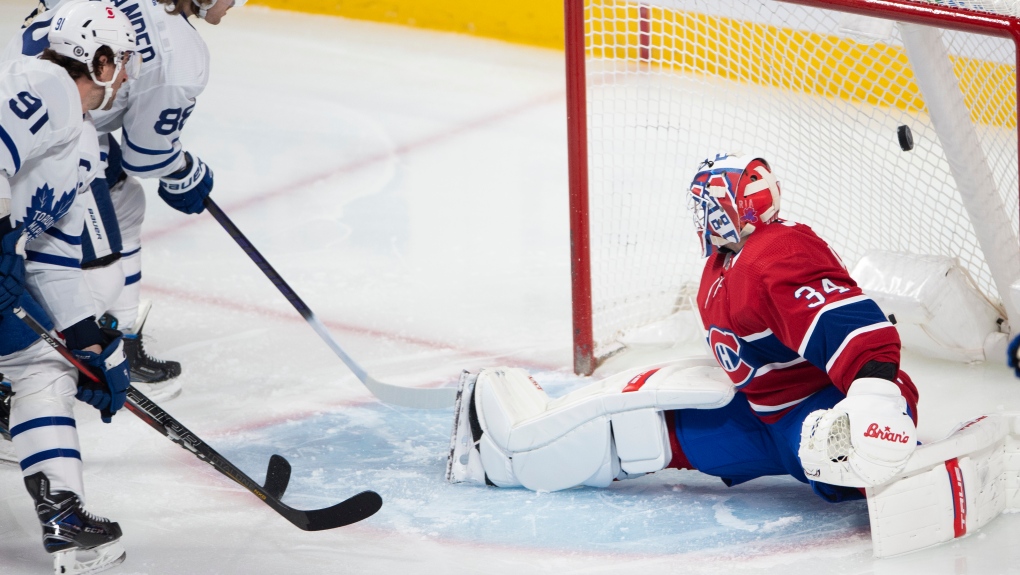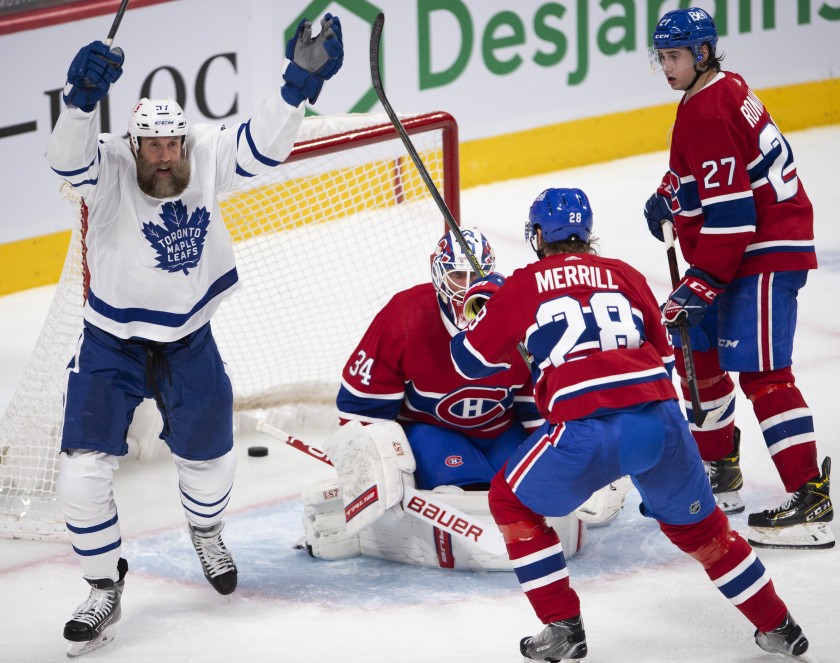It’s finally happening. The Toronto Maple Leafs are playing the Montreal Canadiens in a playoff series for the first time since 1979.
This is a dream scenario for the NHL, particularly in a season where no fans were allowed inside an arena in Canada.
But none of that matters to the Leafs, whose focus is on the task at hand. The team has been eliminated in the first round/play-in round in four straight years. They’ve responded this season by winning the division, but at some point, they need to have some real playoff success, and the urgency has been dialed up a few notches considering the circumstances — including the opportunity to compete in the easiest division they’ve been a part of in well over a decade.
On paper, the Leafs enjoy a healthy advantage across the board:
| Category | Leafs | Habs |
|---|---|---|
| Points percentage | .688 | .527 |
| Regulation wins | 34 | 23 |
| Goal differential | +39 | -9 |
| Goals per game | 3.32 | 2.82 |
| Goals against per game | 2.64 | 2.95 |
| Shots per game | 31.3 | 31.2 |
| Shots against per game | 27.8 | 28.2 |
| 5v5 save percentage | 92.36% | 91.37% |
| 5v5 corsi | 54.5 | 51.01 |
| 5v5 fenwick | 53.73 | 51.66 |
| 5v5 expected goals | 55.14 | 52.93 |
| Power play | 20% | 19.2% |
| Net power play | 15.5% | 17.9% |
| Penalty kill | 78.5% | 78.5% |
| Net penalty kill | 80.6% | 83.7% |
*5v5 stats via Natural Stat Trick
The Leafs, as no real surprise, are more explosive offensively — they create more and they score more. The Habs leading point scorer, Tyler Toffoli, would rank fourth on the Leafs in points this season.
Where things equalize a bit is that both teams have struggled on the power play and penalty kill, and the Habs have generally controlled the shot share better than the Leafs, even if the Leafs produce more quality and have a superior group of finishers.
To see how it might play out, we have 10 Leafs vs. Habs games from this season to review, which is a fairly solid sample size to glean from — albeit there are a number of different moving parts to consider, including the Canadiens’ coaching change, player acquisitions, and players moving up and around the lineup (i.e. Jack Campbell is now the starter over Frederik Andersen).
In those 10 games, the Leafs went 7-2-1 (one of their wins was in overtime). The Leafs scored 34 goals in those games to Habs’ 25. At 5v5, the Leafs scored 25 goals to the Habs’ 16. The 5v5 shot attempts over the 10 games were 424 for the Leafs and 450 for the Habs.
As mentioned, we also have to account for the differences between the Claude Julien-coached Habs and the Dominique Ducharme-coached Habs. In the first four games of the season against Montreal, Toronto lived off of special teams, as only seven of their 15 goals came at 5v5. Since hiring Ducharme, only one of the Leafs’ goals against the Habs did not come at 5v5.
Some of that is purely circumstantial and related to matchup factors. Let’s take a deeper look at those 10 games and break down the announced starting lineups we are expecting for this series.
5v5 Matchups

At this point, it appears we have a good indication of what both lineups will look like.
The Leafs have been running the following group in practice:
Forwards
Hyman-Matthews-Marner
Foligno-Tavares-Nylander
Mikheyev-Nash-Kerfoot
Thornton-Spezza-Simmonds
Defensemen
Rielly-Brodie
Muzzin-Holl
Sandin-Dermott
The Habs are practicing with this lineup:
Forwards
Tatar-Danault-Gallagher
Toffoli-Suzuki-Armia
Perry-Staal-Anderson
Byron-Evans-Lehkonen
Defensemen
Edmundson-Petry
Chiarot-Weber
Merrill/Kulak-Romanov
For the Leafs, everything starts with the Auston Matthews line. For the Habs, everything starts with their top line led by Phillip Danault, which is a very good shutdown unit.
Matthews has eaten against the Habs with 14 points in 10 games (Marner has 11 points in 10 games), but that has not been the story against Danault. Matthews and Danault played eight games against each other and the results in that specific matchup are the main thing the Habs can hang their hat on to this point: Matthews and Danault have played 73:38 minutes head-to-head in 5v5 action so far this season, with Danault winning the shot share 77-62, and Matthews winning the on-ice goal battle 3-2.
Those are not great numbers for Toronto, and if Matthews is essentially getting hedged by the Danault line while the Toronto power play struggles, that is not a great recipe for success for the Leafs.
I think this is why the Leafs appear hellbent on using Hyman on the first line right off of the hop. Early on in the season, Joe Thornton played alongside Matthews and Marner, but whenever the game was tight — particularly against Montreal early on — Hyman moved up to that line in the third period. It changed the complexion of the game. Of the three 5v5 goals a Matthews-led line scored against the Danault shutdown line, Hyman was on for two of them.
The Leafs are more than a one-line team, though, and Tavares and Nylander have been fairly successful against the Habs this season as well. Tavares has racked up 10 points in 10 games against them, while Nylander has seven points in eight games. The Habs have thrown a number of different looks at that line — the most common of which is a Nick Suzuki-centered line, which was done primarily by Claude Julien before he was let go.
Head-to-head at 5v5, Tavares and Suzuki have actually been on for and given up three goals apiece against one other. Some of it is due to injury, but the Habs also played two games where they used Eric Staal against Tavares the most, and two others where it has been Jesperi Kotkaniemi (including game one of the season) drawing the matchup. The one constant has been the Joel Edmundson – Jeff Petry defense pairing playing against Tavares’ line when the two teams have been relatively healthy.
It will be worth monitoring whether Nick Foligno can generate a forecheck and force one of those two defenders to stick with him in front of the net. That will open up space for Tavares and Nylander to operate. We’ve seen that type of role lead them to success, even as early as when Alex Galchenyuk embraced his role as a forechecker.
The forward matchup here will also play to strategy, and it could be an area where home ice comes into play. The Leafs may decide that they want Riley Nash and the checking unit going against the Habs’ two highest-scoring forwards (Toffoli and Suzuki). That would mean a potential matchup for the Tavares line against Staal’s unit with Perry and Anderson.
It won’t be a hard matchup either way — that’s how you end up playing John Tavares 16 minutes in the playoffs — but there is some opportunity for the Leafs to shuffle around the lines in the mushy middle.
Any plans the Leafs have right now are also contingent on a bit of a wildcard line. Riley Nash hasn’t played a game as a Leaf, and while he’s a nice enough player for his role (a shutdown center), he’s really more of a fourth-line center on account of his lack of scoring. Meanwhile, Mikheyev and Kerfoot, to this point, have not been able to drive much in the way of offense.
That means the Leafs will need the veteran fourth line to chip in. As a unit, Thornton – Spezza – Simmonds has only played 24 minutes together at 5v5 (they’ve yet to score or be scored on), but Spezza and Thornton have played over 130 minutes together at 5v5 (they’re below water in shot share, but they have scored seven and been on for six against).
Conversely, the Habs have a fourth line of Byron – Evans – Lehkonen that has been a sneaky good trio, with a 51 CF% in 156 minutes together, along with six goals scored and three against, although their expected goals is just under 50%.
It should also be noted that the Perry – Staal – Anderson line the Habs appear to be putting together has played nine minutes as a trio so far this season. While the Leafs are banking on putting together a new unit that can provide quality shutdown minutes, the Habs are banking on putting together a third line that can score — they don’t have the same firepower that the Leafs do at the top of their lineup.
In summary, both teams have fairly big question marks in their bottom six and a bunch of new line combinations they’ve recently assembled. That will mean even more responsibility for the top lines. In any scenario where the Matthews line is able to score regularly against the Danault line, it would tilt the series drastically in the Leafs’ favour.
Special Teams

Both teams have been so poor on special teams recently, it’s possible that they simply cancel each other out.
Since the start of April, the Leafs’ power play has been clicking at 10 percent, tied for 27th — with the Los Angeles Kings (!) — while the Habs haven’t been much better at 14.3% — good for 21st in the league. Their penalty kills have been marginally better, sitting 17th (Leafs at 81.4%) and 18th (Habs at 81%) in that same time period.
Where it maybe gets a bit more interesting is that the Leafs’ net power-play percentage in that time is 2% percent, while the Habs are tied with the Bruins for the most shorthanded goals in the league. Despite all the Leafs’ talent, here we are discussing whether or not the Habs might actually be the team to score when the Leafs embark on a power play.
From Toronto’s end, it’s pretty simple – they need to gain the zone better. We have talked a lot about in-zone setup (and there should be changes there as well), but at the end of the day, we all know who the five players are going to be. What really kills them more than anything is the repeated attempts at the drop-pass power-play breakout that simply isn’t working.
Everyone knows what’s coming, and the Habs are no different. They can stand the puck carrier up and force sloppy passes that lead to giveaways. The Leafs just played the Habs three times in a week and failed to score a single power-play goal, including a full two-minute 5v3.
At a minimum, the Leafs need to gain the zone and at least create some chances. Other than a shorthanded goal against, the worst-case scenario is a power play that is shutdown so easily that the Habs are actually able to swing the momentum.
On the penalty kill, the Habs run with Weber and Chiarot the most followed by Edmundson and Petry. At forward, Danault is their primary penalty killer alongside Lehkonen. They also rotate in Evans, Byron, and Armia. The speed of Byron is particularly disruptive, while Armia is good at clogging up passing lanes with his reach.
At times, the Leafs have been able to get the Habs to overcommit to Matthews (probably because he has burned them so many times) and it opens up prime scoring opportunities for his teammates (see the Nylander tap-in from a few weeks ago). There is an opportunity for the Leafs to regularly create something off of that.
On the other end, the Habs power play has also struggled. Right now, they are practicing with this unit:
Perry
Toffoli Gallagher Suzuki
Petry
It should be noted that Weber is not included above, and they do like to run two defensemen on the power play at times since both Petry and Weber own big shots.
That can work to the Habs detriment, too, though – Weber and Petry are first and third on the Habs, respectively, in power-play shots per 60 minutes, but their leading goal scorers on the power play are Toffoli and Suzuki (Toffoli, it should be noted, is the player who is second in shots per 60 between the two defenders).
The Leafs’ speed is critical here. Marner, Hyman Mikheyev, and Kerfoot are all fast enough that they should be able to challenge the Habs’ defenders and disrupt them, giving them fewer opportunities to tee off.
On defense, the Leafs run with Muzzin – Holl as much as possible, and those two will need to deal with Perry in front of the net, as well as stay on the lookout for Suzuki, who is a crafty passer and will try to work the puck backdoor, to the bumper, or even down low for a prime scoring opportunity.
Unless these units really turn a corner, the special-teams battle won’t be much of one. At this point in time, you could argue the most dangerous threat here is the Habs shorthanded.
Miscellaneous Notes

- Going through the video of the Leafs vs. Habs games this season, one thing that stood out is how the Leafs like to pull a forward high in the offensive zone and have that player run the point with the puck — and how much it can discombobulate the Habs. Montreal switched to more of a man-to-man defensive zone coverage under Ducharme compared to more of a zone scheme under Julien. The Leafs love running little picks and rubs in the offensive zone (particularly Hyman, and now Foligno), which will help them open space to create in the offensive zone.
- The Canadiens’ defensemen can be very aggressive along the offensive blue line and through the neutral zone when they see an opportunity to step up. Weber, Petry, and even Edmundson are all very active, and they are big men who cover a lot of space with their wingspans. However, it’s risk-reward — there’s opportunity to burn them for odd-man rushes.
- Sandin – Dermott might sound fun, but this is a really unproven defense pairing that has played under 50 minutes together this season at 5v5 (with a 46 CF%). The Leafs had three defensemen average over 21 minutes per game this season — including Rielly at over 23 minutes per game — but the top four might see a notable increase across the board in ice time in order to really shelter this third pairing.
- Both teams have question marks in net for all sorts of reasons. It might not seem like it, but goaltending was a big part of the Leafs success this season – they had the seventh-best 5v5 save percentage in the league this year. Campbell has done everything they possibly could have asked of him so far, but the playoff question will loom large until he proves he’s capable of handling it. It’s a big workload — playing every other night — and the spotlight shines much brighter in the playoffs.
I
Price has been below average and Allen hasn’t been that much better, but both have put on strong playoff performances before, including Price last summer. At the end of the day, though, if the option is one goalie who has been really good this year compared to one goalie who really hasn’t, the advantage seems fairly straightforward. - I was not surprised to see Cole Caufield on the outside looking in to start the series as his numbers at 5v5 have not been great. Kotkaniemi, on the other hand, is a surprise. He built off a good playoff showing last year and had a solid season on the whole. You have to assume he gets in at some point.
- In the same breath, you have to imagine Pierre Engvall gets in at some point in the playoffs. His speed can make a difference, and he might actually be better scoring depth than most of the players the Leafs are set to run in their bottom six.
- While depth is always critical in the playoffs — and it will be in this series, too — I think the X-factors of this series are really simple: For the Habs, if Danault and Gallagher can’t neutralize the Matthews line, it won’t be much of a series for them. For the Leafs, if Tavares and Nylander take care of business against the Habs’ second and third lines, that will be one too many headaches for them to handle.
- Another X-factor for the Leafs is Morgan Rielly, who has averaged massive minutes on the Leafs blue line year after year — head and shoulders above his teammates — come playoff time. If you’re going to play nearly half the game, you have to make good on those minutes. In the playoffs (not counting that Columbus play-in), he has 15 points in 20 playoff games.
I
Rielly can’t fix the power play on his own, but he can definitely help get it trending in the right direction. The drop pass on the power-play breakout appears systemic and completely out of his control, but he can offer so much in that regard with his speed and puck-carrying ability. For long stretches of time, Rielly has been a one-man power-play zone entry. It’s certainly not too late for him to be more active and aggressive in that regard. - It is going to sound like I’m bitter, but I just can’t wrap my head around the fact that the Canadian teams have to play on back-to-back days in the playoffs. If you’re going to insist on finishing the season with Vancouver and Calgary, so be it, but don’t punish the teams that actually made the playoffs.
Series Prediction

The Leafs are in the upper echelon of teams in the league, while the Habs technically did not finish in the top 16. In a normal season, it’s fair to wonder if Montreal would have made the playoffs.
That said, they present a number of challenges for the Leafs, particularly due to their shutdown line and overall depth. At the end of the day, though, the Leafs have too much elite talent, and it is now a bit more battle-tested and in its prime. I’m finding it hard to picture the Habs winning four of seven unless something goes off the rails for the Leafs with their goaltending or special teams (which isn’t impossible).
My head is saying Leafs in six, while my heart is saying Leafs in seven because they never do anything the easy way. I’ll stick with my head on this one — Leafs in six.

































